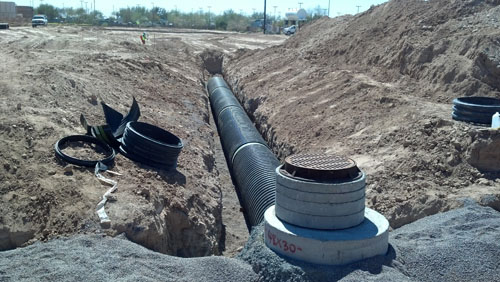Sewerage
Sewerage (the sewer system), is the underground networks of pipes that carries sewage (waste water and excrement), waste water and surface water run-off, from buildings to treatment facilities or disposal points.
A sewer is; 'A pipe or channel taking domestic foul and/or surface water from buildings and associated paths and hardstandings from two or more curtilages and having proper outfall' Ref The SuDS Manual (C753), published by CIRIA in 2015.
Types of sewer include:
- Sanitary sewer: Used solely for carrying sewage.
- Surface water sewer: Used to drain groundwater and excess water from impervious surfaces.
- Combined sewer: Used to carry both sewage and surface water. This type of sewer can lead to water pollution problems when overflow conditions are experienced.
- Effluent sewer (sometimes referred to as Septic Tank Effluent Drainage (STED) or Solids-Free Sewers (SFS)) : These collect remaining sewage from septic tanks and carry it to a treatment plant.
- Separate sewer: For surface water or foul sewage, but not a combination of both.
There are a number of ways of moving the contents of sewers:
- Gravity sewers use differing elevations to facilitate movement.
- Force mains use pumps where sewers are at a lower elevation than the destination.
- Vacuum sewers use differential atmospheric pressure.
A sewerage undertaker is: 'A collective term relating to the statutory undertaking of water companies that are responsible for sewerage and sewage disposal, including surface water from roofs and yards of premises.' Ref The SuDS Manual.
In September 2010, the government announced that most private sewers that connected to the public sewer network would be transferred to the ownership of the regulated sewerage companies in England and Wales. Private sewers that were connected to the public sewer network before 1 July 2011 were transferred on 1 October 2011.
- A drain is a pipe that serves only one building, conveying water and waste water to a sewer. A lateral drain is a section of drain positioned outside the boundary of a building, connecting with the drains from other buildings to become a sewer.
- Combined Sewer Overflow (CSO) is: ‘A structure on a combined or partially separate sewer system that allows the discharge of flow in excess of that which the sewer is designed to carry, usually to a receiving surface water body.’ Ref The SuDS Manual.
[edit] Related articles on Designing Buildings
- Are sustainable urban drainage systems the response to our changing climate?
- Biosolids.
- Cesspool.
- Civil Engineering during the Industrial Revolution in Britain.
- Clarified water.
- Difference between drains and sewers.
- Drainage.
- Drainage and sewerage management plans DSMPs.
- Drains.
- Grease management.
- Groundwater control in urban areas.
- Lateral drain.
- Maintenance of drainage systems to prevent flooding and water pollution.
- Miasma theory.
- Outfall sewer.
- Pipework.
- Private sewer.
- Public Health Act 1875.
- Public sewer.
- Pumping station.
- Reed bed.
- Safe working in drains and sewers.
- Sanitary pipework.
- Section 102 existing sewer adoption.
- Section 104 new sewer adoption.
- Septic tank.
- Sewerage company.
- Sewer construction.
- Stink pipes.
- Sustainable urban drainage systems SUDS.
- The redevelopment of Leicester's sewerage system by Joseph Gordon.
- Three pieces of infrastructure that have saved lives.
- Waste water.
- Water transfers and interconnections.
Featured articles and news
One of the most impressive Victorian architects. Book review.
RTPI leader to become new CIOB Chief Executive Officer
Dr Victoria Hills MRTPI, FICE to take over after Caroline Gumble’s departure.
Social and affordable housing, a long term plan for delivery
The “Delivering a Decade of Renewal for Social and Affordable Housing” strategy sets out future path.
A change to adoptive architecture
Effects of global weather warming on architectural detailing, material choice and human interaction.
The proposed publicly owned and backed subsidiary of Homes England, to facilitate new homes.
How big is the problem and what can we do to mitigate the effects?
Overheating guidance and tools for building designers
A number of cool guides to help with the heat.
The UK's Modern Industrial Strategy: A 10 year plan
Previous consultation criticism, current key elements and general support with some persisting reservations.
Building Safety Regulator reforms
New roles, new staff and a new fast track service pave the way for a single construction regulator.
Architectural Technologist CPDs and Communications
CIAT CPD… and how you can do it!
Cooling centres and cool spaces
Managing extreme heat in cities by directing the public to places for heat stress relief and water sources.
Winter gardens: A brief history and warm variations
Extending the season with glass in different forms and terms.
Restoring Great Yarmouth's Winter Gardens
Transforming one of the least sustainable constructions imaginable.
Construction Skills Mission Board launch sector drive
Newly formed government and industry collaboration set strategy for recruiting an additional 100,000 construction workers a year.
New Architects Code comes into effect in September 2025
ARB Architects Code of Conduct and Practice available with ongoing consultation regarding guidance.
Welsh Skills Body (Medr) launches ambitious plan
The new skills body brings together funding and regulation of tertiary education and research for the devolved nation.
Paul Gandy FCIOB announced as next CIOB President
Former Tilbury Douglas CEO takes helm.























